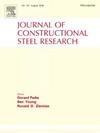采用网格加劲件和金属屈服阻尼器对钢板剪力墙进行创新性改进
IF 4
2区 工程技术
Q1 CONSTRUCTION & BUILDING TECHNOLOGY
引用次数: 0
摘要
地震后钢板剪力墙(SPSW)的修复成本非常昂贵。同样,实现刚度和阻尼之间的最佳平衡设计对工程师来说也是一项挑战。针对上述障碍,本研究提出了一种填充板与框架之间的高效可更换结构保险丝,以提高钢板剪力墙的抗震性能。为此,我们采用了网格加劲件与金属屈服阻尼器(MYDs)来连接填充板和周围的结构框架。为了检验拟议结构模型的抗震性能,利用 ABAQUS 工程软件对 16 种不同情况下的有限元模型进行了细致模拟。然后,对这些模型进行了全面的推移分析和循环分析。结果表明,所提出的 SPSW 模型不仅改善了填充板上的应力分布,还确保了填充板承载能力的最大发挥。此外,所有结构模型在短震事件中都表现出了弹性响应,从而避免了建筑物结构和非结构部件的损坏。值得注意的是,这些结构模型抵御了相当于 5%漂移的位移增加。最后,与传统的 SPWS 相比,所提出的结构模型的有效阻尼提高了 30%,刚度提高了 12%。然而,增加加固区的数量并不会对有效刚度产生明显影响,因为整体结构刚度由薄弱环节决定,在这种情况下,薄弱环节就是 MYD。本文章由计算机程序翻译,如有差异,请以英文原文为准。
Innovative improvement towards steel plate shear walls employing the grid stiffeners along with the metallic yielding dampers
The rehabilitation costs of steel plate shear walls (SPSWs) after earthquakes are highly expensive. Likewise, achieving an optimal balance design between stiffness and damping is challenging for engineers. To address the stated barriers, the current study proposes an efficient replaceable structural fuse between the infill panel and frame to enhance the seismic performance of the SPSWs. For this purpose, the grid stiffeners in conjunction with the metallic yielding dampers (MYDs) are employed to connect the infill plate to surrounding structural frames. To examine the seismic performance of the proposed structural model, the finite element models have been meticulously simulated under 16 different scenarios utilizing the ABAQUS engineering software. Then, the comprehensive pushover analyses besides the cyclic analyses are executed upon these models. The obtained results manifested that the proposed SPSW model not only improved the stress distribution across the infill plate but also ensured the maximum exploitation of its capacity. Furthermore, all structural models exhibited a resilience response in short seismic events, which led to the prevention of damage occurrence in structural and non-structural components of buildings. Remarkably, the structural models have resisted an increase in displacement equivalent to a drift of 5 %. Finally, compared with the conventional SPWSs, the proposed structural model illustrated a higher effective damping of 30 % and stiffness of 12 %, simultaneously. However, increasing the number of stiffened zones has not shown a tangible influence on the effective stiffness since the overall structural stiffness is governed by the weak links, which in this case are MYDs.
求助全文
通过发布文献求助,成功后即可免费获取论文全文。
去求助
来源期刊

Journal of Constructional Steel Research
工程技术-工程:土木
CiteScore
7.90
自引率
19.50%
发文量
550
审稿时长
46 days
期刊介绍:
The Journal of Constructional Steel Research provides an international forum for the presentation and discussion of the latest developments in structural steel research and their applications. It is aimed not only at researchers but also at those likely to be most affected by research results, i.e. designers and fabricators. Original papers of a high standard dealing with all aspects of steel research including theoretical and experimental research on elements, assemblages, connection and material properties are considered for publication.
 求助内容:
求助内容: 应助结果提醒方式:
应助结果提醒方式:


